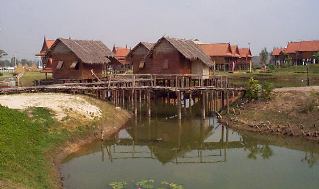|
Four-Region Village of Thailand
|
|
The Bangsai Arts and Crafts Training Centre and the Tourism Authority of Thailand
(TAT) will jointly construct the "Four-Region Village" which gathers arts, culture and way of life of all parts of Thailand.




|
|
Traditional Thai houses were designed to meet the unique challemges of the tropical climate and distinct landscape of the country.
This, combined with the colorful and rich culture of the Kingdom, produced a vivid architectural style unmatched anywhere in Asia.
Most homes were built of natural materials, such as teak, bamboo and dried leaves, which helped keep the building cool.
Many are raised on stills six or seven feet above the ground to stop them from being flooded during the rainy season. But it is the graceful multi-tiered roofs and sinuous
curves of temples and royal houses that are the most memorable images of Thai architecture.
Not just a decorative element, the steeply slanting roof protects the interior from the sun and the rain. Spiritual beliefs are also reflected in the architecture.
The innermost room is believed to house the spirits of the family ancestors, and is usually used as the sleeping quarters. Certain woods were taboo for building because their names have inauspicious associations.
For instance, one wood sounded like "corpe", while the yon tree was never used because it was believed the tree harbored spirits that would bring bad luck to the house.
|

|
|
The Thai house -- actually a group of houses joined together -- is designed to suit the Thai lifestyle and climate.
Elevated with graceful sloping repes, the house is prefabricated and the units are bolted
together without using a single nail.
Thai houses in all parts of the country are
invariably single story and raised on posts. The main
unit is linked to other units by a verandah, which
serves perfectly well in merit - making functions.
Thai houses are open with a free flow of space, but
they slightly differ from region to region.
In the Central Plains, houses are elevated to
avoid floods. They are often refered to as amphibious
houses. In the North, the graceful kalae that adorns
the gable indicates the houseowner's social status.
Thai houses do not only represent Thai life
but also serve as showcases of the fine texture of
wood, elaborately and lovingly decorated with carvings which
epitomize Thai fine craftsmanship at its best.
|